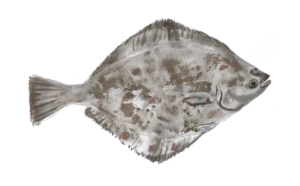If you’ve been fishing for bass information, even for a short while, you’ve likely realized that there are dozens of bass fish out there. What’s not always so clear, however, is that not all fish called “bass” are related. A big group of them are. Those are the fish in the sunfish family (a.k.a. the black basses), like largemouth and smallmouth bass.
The black sea bass, however, belongs in the grouper family. It’s strictly a saltwater fish and tastes fantastic. They’re well worth fishing, which is why this article is going to go in-depth to give you what you need to know about the black sea bass. First, we’ll get to know our quarry with a little ecology of the black sea bass, then we’ll dive into the gear and techniques used to catch black sea bass, and finally we’ll share a few ideas about how to cook up black sea bass.
What is a Black Sea Bass?
In order to catch a black sea bass, it’s important to know how to identify one. It’s also a good idea to be aware of the catch limits in your area. This fish is not endangered, but there are federal size limits in place to manage the population. As of now, private recreational fishing is reported on a voluntary basis, but if you’ve chartered a boat, operators must submit a report at the end of the trip.
The black sea bass, as you might imagine, is distinguished by its dark coloration. Males are an especially dark green-gray and the females are lighter in color; often a dusky brown. Juvenile black sea bass are lighter too and darken up as they get older. They go through several color phases on their way to maturity, including a striped phase. During mating season, the males can develop fluorescent blue coloration around the eyes and a fatty hump in front of the dorsal fin. The head is free of scales and the scales that cover the rest of the fish’s body are a lighter color in the center with a dark border. This gives the illusion of lateral stripes down the sides of the lighter-colored fish.
These fish have a pointed nose with eyes high in front. The mouth is downturned and extends well past the eye. The pectoral and pelvic fins are large and roughly the same size and shape. This fish will often rest on its pelvic fins when at the bottom surface of the water, posing like a strange underwater dog. Black sea bass have high spiny dorsal fins, longer on males than on females. This fin often has white speckles or stripes on it. The tail fin is continuous and blunt. They can grow up to about two feet long, but are usually found at half that length. The record weight for a black sea bass is nine and a half pounds.
The reproductive habits of this fish are interesting to note. Some of them begin life as females, but then transform to become males. Whether they go through this change or not depends on the conditions of the breeding population. If there are already enough males around in the spring mating season, the females don’t change. If males are scarce, however, the females make the change to fill the vacancies. The fish is able to breed as a male after the transformation. Males live longer, up to twelve years, while the females only live about eight. They can produce well upwards of 30,000 eggs in one spawning season.
For a breakdown of the different types of bass, check out this Rusty Angler article.
Where to Find a Black Sea Bass
Black sea bass are found, naturally, in the sea. They are strictly saltwater fish and have a relatively small range worldwide. Globally, black sea bass can only be found on the east coast of the United States, through the Gulf of Mexico, and down along the eastern Mexican coast. Cold weather will sometimes drive populations further south than their customary range, past the Florida Keys. They spend some of their time offshore in depths up to 430 feet. That’s where you’ll find most of the bigger fish. During breeding season, they move in closer to the shore and will come into waters as shallow as twenty feet. Depending on the quality of the water, you may be able to spot them from the surface at that depth.
There are two overlapping stocks of black sea bass: a northern stock and a southern stock. The northern stock’s range is from North Carolina up to Massachusetts. This population migrates with the seasons, spending winters in deeper waters within the southern part of their range. The second stock of black sea bass is found south of North Carolina and doesn’t move around as much as their northern counterparts because temperatures are more consistent year round. Both stocks of these fish are otherwise the same in behavior and appearance and they do share the same waters where their territory overlaps.
Within their long coastal range, black sea bass like to spend their time at the bottom of the water. They prefer a rocky or shell surface and don’t really enjoy being in the mud or soft sand. Look for them around structures like wrecks, pilings, docks, and rock piles in an otherwise flat area. Mating season, when the fish congregate in the shallower waters, varies up the coastline. In the Massachusetts area, mating begins in May and lasts until mid-June. In Florida they spawn between January and March. These are the easiest times of the year to find and catch black sea bass.
Depending on where you’re fishing for black sea bass, different regulations apply. Make sure you have a license where required and know what the catch limits are. You don’t want a day out on the water ruined by an unfriendly visit from the local game service. Chances are, they don’t want to be out busting people either, so make it a good day for everyone by following the local rules. As of now, federal restrictions published by NOAA limits recreational catches to fifteen fish that must be 12.5 inches long or more. The federal season for these fish is the whole of February and then May 15 through the end of the year. Each state has their own regulations, however, so it’s best to check on those before planning your trip.
How to Catch a Black Sea Bass
As we’ve learned in the information above, this fish likes to chill out at the bottom of the water. So, that’s really the best place to present your bait. That’s not to say you will never find them striking at the surface. It’s not uncommon to snag the occasional black sea bass when casting for stripers or bonito. For the most part, however, you want to drop your bait down to the sand.
Using lighter gear when going after this fish will be much more rewarding if you’re looking for a fun fight than if you use a deep sea setup. A medium weight rod of around seven feet will do nicely. Pair it with a spinning reel and some twenty pound test braided line and you’re good to go. Attach a three or four foot fluorocarbon leader by way of a barrel swivel and then choose your bait.
When it comes to attracting black sea bass to the hook, there seems to be two schools of thought on the matter. There are anglers who swear up and down that live or cut bait is the only way to go. The other camp of anglers will tell you that sea bass will strike on anything and to save yourself the trouble of live bait. Regardless of which way you want to go, we’ve got you covered with live bait and artificial lure recommendations.
Best Bait for Black Sea Bass
Black sea bass eat bottom dwelling creatures in the wild. This includes worms, clams, crabs and shrimp. Since they’re opportunistic feeders, they’ll go after all sorts of things, but those are their favorite munchies. The most popular bait for black sea bass among anglers is definitely squid strips. Maybe that’s because they want to save the shrimp and crab for themselves! Using squid has its downsides. Aside from the mess and stink of cut squid, using it will attract all sorts of critters to your lure. A dogfish or a sea robin will just as readily go after your squid as soon as a sea bass would.
Best Lures for Black Sea Bass
As far as artificial lures go, it’s hard to miss with a bucktail jig. You can also rig a jighead with a Gulp! Saltwater jerk shad or Gulp! Pinched worm. The Acme Kastmaster XL Silver is a highly recommended lure for black sea bass because it’s got a good combination of weight and sleek design. Shimano makes a diamond jig that works just as well. Your best bet is to offer a variety of these and see how it plays out.
When it comes to casting your line, drifting is preferred over anchoring, unless you find a great spot with a lot of fish. Drifting enables you to cover more area, which is especially good if you haven’t located the bass yet. When you’ve found an underwater structure that looks promising, head a little way upcurrent from it and freespool your jig until it hits bottom. Then, with your rod tip near the water’s surface, hop that lure along the bottom.
How to Prepare & Cook Black Sea Bass
One of the very best parts of black sea bass fishing is getting one on the plate. These fish have a mild taste and firm texture. They’re also one of the lower calorie fish you can eat because they tend to be on the lean side. At slightly less than a calorie per gram, the fish on its own doesn’t deliver a huge punch to the diet. Depending on how you cook it up, however, will certainly change the calorie count. There’s a low risk of mercury in this fish and for that reason, it’s unadvisable to eat it more than once a week.
We’ve collected a few recipes that offer a little more kick than your standard lemon-pepper filet and yet not so adventurous that you’ll be nervous to try them. Let’s start with a bit of an Eastern flare with this recipe for Miso glazed sea bass from the folks at Williams Sonoma. Miso is well-known as a soup ingredient, but it can be so much more. Use a bit of white miso paste, combine it with some sake, and add fresh ginger to make a marinade. Broil the fish, flipping the filets and basting with marinade for about four minutes on each side.
If you like to cook your fish whole, try this Epicurious recipe for Whole black bass with ginger and scallions. It’s actually steamed in the oven under a foil tent. A little soy sauce adds a salty brine and a sprinkle of scallions and ginger over the top gives the fish a nice flavor while allowing the natural taste to shine through.
Finally, who would say no to a bit of Grilled black bass with celery salsa verde, a recipe from Fine Cooking. It’s another whole fish recipe, but this time the bass is cooked on a well-oiled grill. First, stuff the fish inside with lemon slices and either toss into a grill basket or tie with butcher’s twine. Fresh herbs, celery, vinegar, and olive oil come together into a refreshing salsa that goes over the top of the cooked fish.
That wraps up our time with the black sea bass. We hope you’ll enjoy catching and eating this delicious saltwater fish. As always, be safe and have fun!
You may also like: How to Catch an Asp



